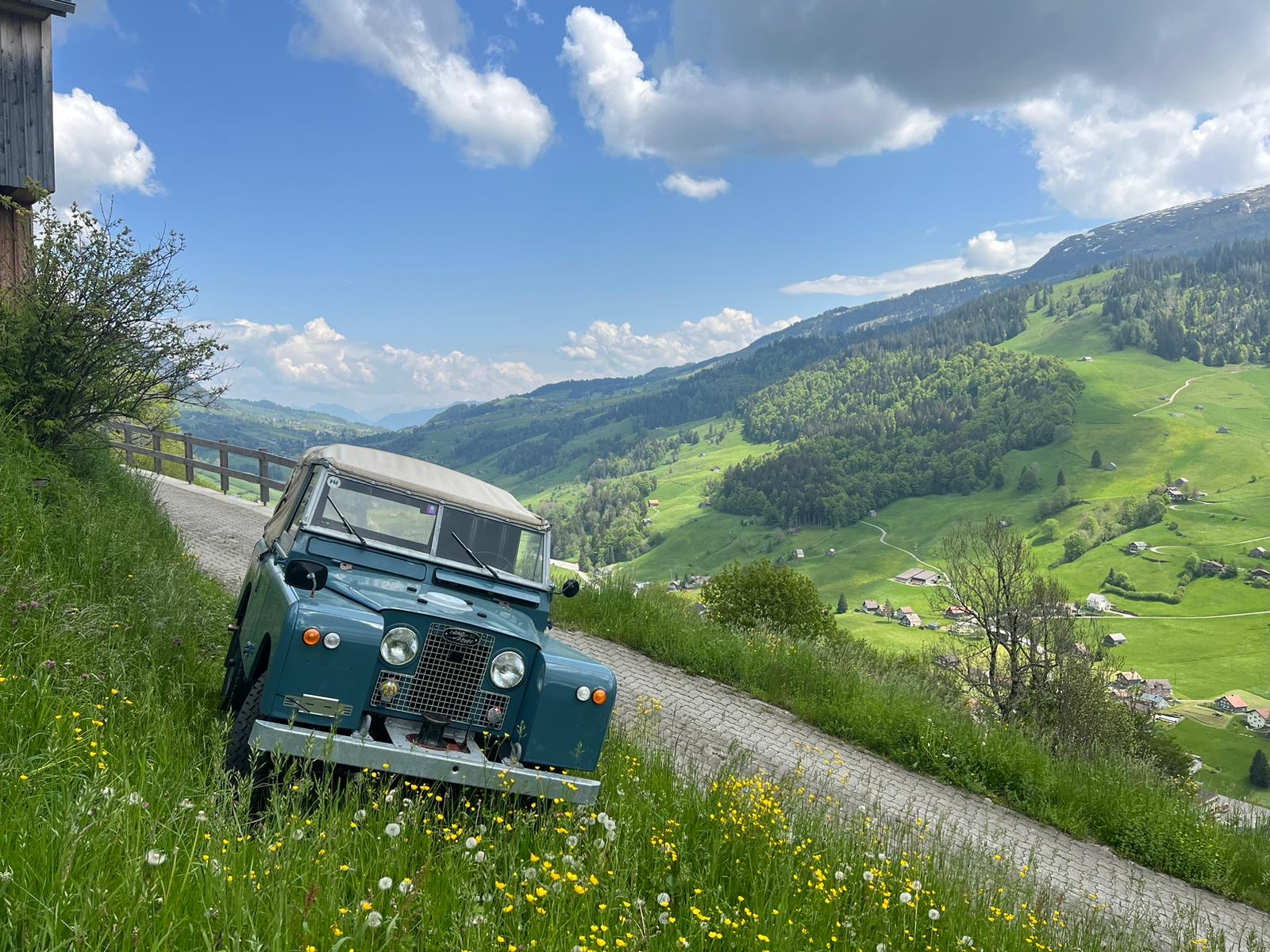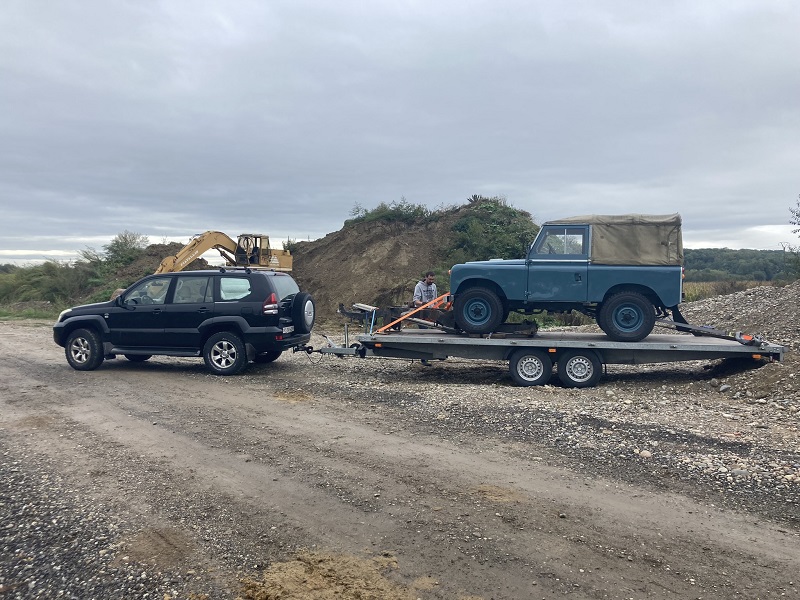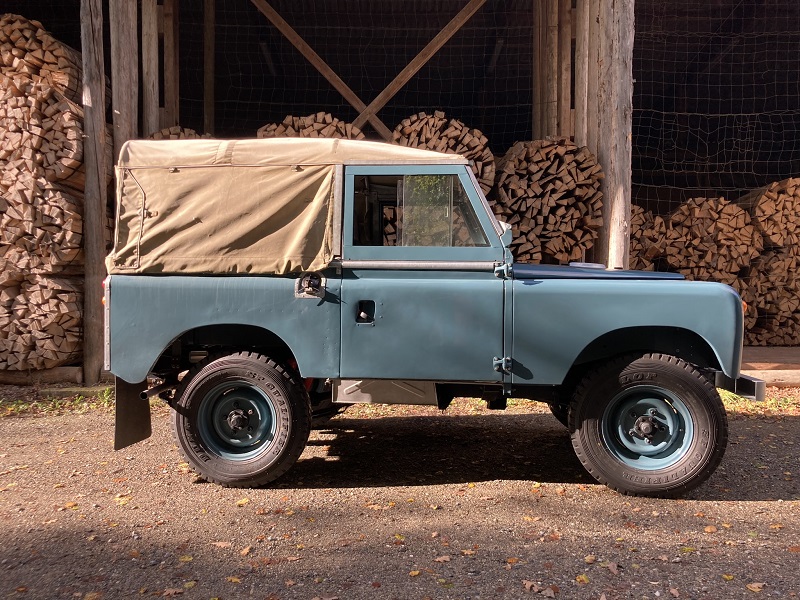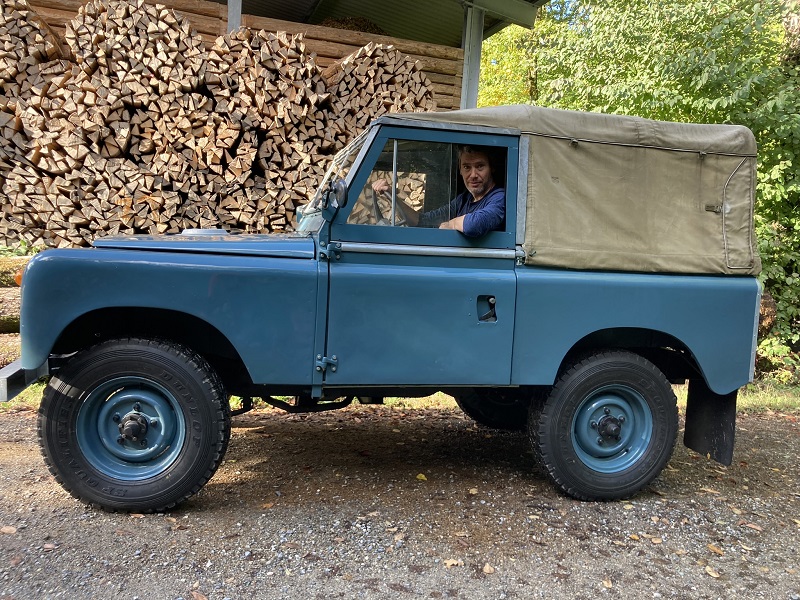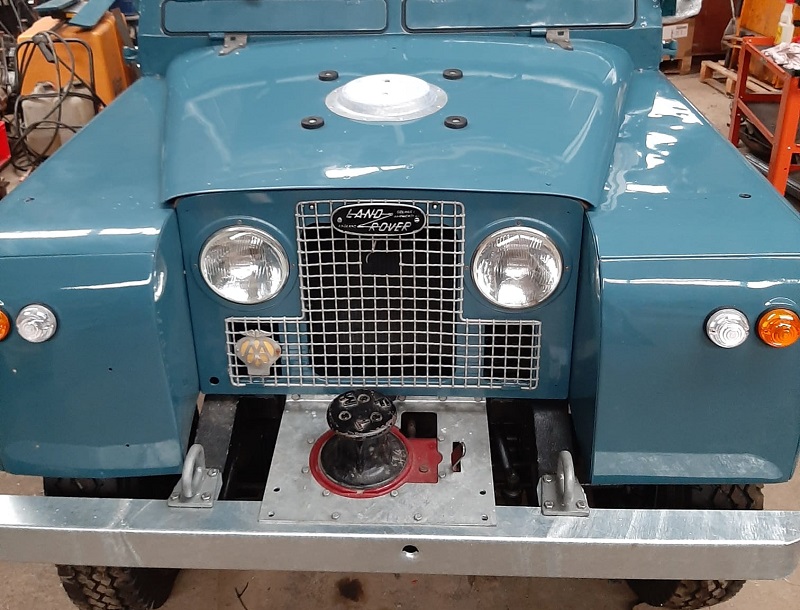
A priceless accessory
Victoria's capstan winch was originally installed under a Range Rover Classic bonnet, dating from the 70's: a very rare installation, since the pricely Range Rover was seldom destined to be used as a workhorse.
Functioning principles
The working principle is similar to the sailing boat winches, using two jointly forces:
-Firstly, the winch bollard's rotation itself, which is mechanically driven, is using the car's engine power as its source of energy.
-Secondly, the traction is hand triggered: the winch operator must be pulling the free side of the rope, tightening its grasp around the rotating bollard, therefore triggering the traction. As soon as the operator releases his own pull, the rope slips again around the moving drum, slowing down or stopping the winching. This means that at all times must a person be outside to operate the winch.

A manual lever, located next to the drum, (dis)engages the dog clutch connecting directly onto the engines crankshaft. Obviously must this lever be in OFF position when the car is driven on the road. If you forget to do so, the cranky noise of the (too fast) rotating drum would soon remind you that something is wrong!
The rope is of a specific kind, in order to achieve the expected grip around the drum, but also to safely slip when needed. Recommended quality is a 3 strand natural Manilla rope (or polypropylene acc. to Land Rover manual), in 24mm diameter, offering a max breaking load of 7 tons, with a 8 tons hook on one end. (LR parts: RTC7030). Length is without any limit, but 15 to 25 meters common.
The engine of the car, powering the winch, must be kept at a 800-1000 rpm speed to deliver adequate and stable power. For the regular user, a hand accelerator and a rev counter are two advisable accessories to equip the car with, in order to helping manage the towing operations. The combination of an engine revving on a still vehicle is a potential overheating situation: equipped with a permanent cooling fan and over-dimensioned radiator, the Land Rover would not overheat, even when operated in the hottest environments. This being said, the optional Dual Gauge, showing coolant temperature, can be seen as a safe addition for the regular user.

Safety in action
Specific to the capstan winch, a brass shear pin (LR parts: FWL 5095-A4), acting as a mechanical fuse, is allowing the drive shaft to stop running if the traction exceeds the maximum recommended load (around 1.3). These pins must be selected with care (several breaking limits exist) and should never be bypassed using any other metallic ersatz. It is advisable to carry a spare one for in the field replacement.All in all, if the capstan winch is a useful tool for light work, it requires specific skills when used at a vehicle recovery or as a heavier loads mover. The fact that an operator must be outside at all times, but that switching off the engine is only possible from the inside of the cabin, makes an emergency stopping procedure tricky to accomplish.
It is highly recommended to be two persons to safely operate a capstan winch, or one operator alone only if skilled and doing light work.

Always keep in mind that these capstan winches are old devices: they have running parts and gears that are decades old and, even if properly maintained, that could suddenly seize or create frightening situations.
Beware at all times!

Before you start
Check that you have the relevant protection equipment. Gloves are mandatory. Check that the rope is clean, exempt of any weak points.
Before any action, check winch oil level, using the level gauge (2 liters EP90). Check that the adequate brass shear pin is in place on the drive shaft.
Engine stopped, engage the drive shaft and then start the engine at idle speed (@ 700 rpm). Check that the capstan turns freely with no suspect noise. Verify that disengaging lever works, as it should.
Leave the driver's door opened at any time, if possible opening it fully, so that the door aligns against the front wheel arch. Mentally simulate the chronology of quick actions to undertake in case of an emergency.
Now, you are good to prepare the winching setup.

Scenario 1: pulling a load towards the car
First, position the Land Rover in a way that it can drag the load in a straight line.
Having selected the 4WD position, pull the handbrake, which locks the transmission, hence the 4 wheels. The transfer gearbox red knob lever must be left in NEUTRAL position. “The neutral position mid-way between "high" and "low" is quite definite and is used with the power take-off pulley for stationary work.” @Land Rover Manual.
When used to pull heavy loads on severe declines or under loose ground, in order to avoid the Land Rover to slip towards the winched load, additional specific wheel anchors can be used, but they are heavy and bulky items. Whether possible, chock the car's back wheels and secure the car from the back, using its tow ball for example. It can be an easier way to get around that problem.

Start by attaching the hook side of your rope to the load to winch in. The bollard turns counter-clockwise. This is why when you walk back to the car, pulling the rope loose, you must pass a U loop under the roller, then above the bollard, so that the free end exists on your left hand (under the roller, or not).
Depending on the weight to pull, hence on the grip needed, you can wind the rope in an ascending spiral up to three times around the (still immobile) capstan drum, counterclockwise. The more turns, the less you will have to use muscles force on the free end. Walk away from the car again, this time pulling loose with you the rest of the rope up to the place you chose to operate the traction.
Not any objects should stand in the rope’s way. The rope, when tightened, should not touch anything else than the rolling bar (never its vertical fixing points, which can damage the rope) and the winch drum: change your position if this is the case!

Some think that the two ends of the rope should pass under the roller, but in most of the cases, only the towing one is enough. Having the two ends under the roller is certainly safer in heavy-duty circumstances, or working alone, but it also means that you have to stay quite in front of the car.
Select the engine rev at recommended speed (@ rpm), leading to accelerating the capstan rotation. An operator must stay in the cabin answering orders to adjust the engine speed (or kill the engine), or you can use a hand accelerator if you are alone.
At that time, the drum should turn freely inside the rope loops, without generating any pulling power.

Ready to get some traction?
Gently pulling on your side of the rope, try to get the feeling of the slipping rope tightening around the winch drum. As soon as the rope gets enough grip, the traction of the load starts. Immediately try to release your own traction to check that the rope slips again, stopping the pulling, as it should. If you succeed, you can now start moving the load direction to the car!
The more you pull on the rope, the faster it winches in.
Do not bring the load too close to the car if it is on the ground, so that the rope does not rub on the front bumper. It is necessary to fold everything, to move the car to a new appropriate position once this happens. And to start again, until you have moved the load up to the place you want to bring it to!

Scenario 2: self recovery
The Land Rover is stuck, cannot moved by itself, but its engine is still ticking fine ? You can recover the Land Rover using its capstan winch.
The anchoring point must be straight in front of the car. Indeed, between the drum winch and the attaching point, the rope should not touch anything than the capstan roller. If no anchoring point is located in that way, you can use a pulley to tow at angle and, finally, reach a firm fixed point.

Start by attaching the hook side of your rope to the solid point to winch to.
The drum turns counter-clockwise. This is why when you walk back to the car, pulling the rope loose, you must pass a U loop under the roller, then above the bollard, so that the free end exists on your left hand (under the roller, or not).
Depending how deep the Land Rover is stuck, hence on the extraction force needed, you can wind the rope in an ascending spiral up to three times around the (still immobile) capstan drum, counterclockwise. The more turns, the less you will have to use muscles force on the free end.
Walk away from the car again, this time pulling loose with you the rest of the rope up to the place you chose to operate the traction.

Select the engine rev at recommended speed (@ rpm), leading to accelerating the capstan rotation. An operator must stay in the cabin answering orders to adjust the engine speed (or kill the engine), or you can use a hand accelerator if you are alone.
At that time, the drum should turn freely inside the rope loops, without generating any pulling power.

Ready to get some traction?
Gently pulling on your side of the rope, try to get the feeling of the slipping rope tightening around the winch drum. As soon as the rope gets enough grip, the car starts moving forward. Immediately try to release your own traction to check that the rope slips again, stopping the towing, as it should.
If you succeed, you can now start towing the car!

The more you pull on the rope, the faster it tows in the car.
Do not bring the car too close to the towing point, so that the rope does not rub on the front bumper.

BONUS: what if the engine is dead ?
Well… your very last chance is to have brought with you a starting handle. Ideally, you have the shorter version, especially made to crank into the Fairey capstan winch.
Winching
Dog clutch disconnected, so that the drive shaft is not locked to the engine’s crankshaft, you can use the crank handle to manually wind the winch manually. It means that if the car’s engine is not working, you can (with a lot of patience and liters of sweat) still operate manually the winch.

Engine hand start
You can manually kick the engine in case of a faulty starter, even when the capstan winch is installed, blocking the direct crankshaft access, using the specific handle. For this, you will need the specific shear pin (LR parts: FWL 5095-A4) which is thicker than the fuse one described above. This will avoid breaking the weaker “safety” shear pin under the compression torque that needs to be exercised to start the engine by hand.
Good to know
you can turn both ways ! The crank handle is the only mean to UN-wind a capstan winch ! In specific situations, it can become very handy…
Useful websites, if you have deep pockets:
--lr-winches.com (2023): the reference website to find complete assemblies but also each single part to get your capstan running. A gold mine.
--lroe.co.uk/Aeroparts-capstan/ (2023)
-embertonimperial.com (2023)
-lrbits.co.uk/manilla-capstan-winch-rope-fairey-aeroparts (2023)
